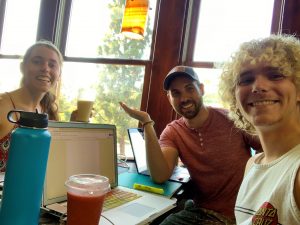
Going into our internship at CMIL, we really weren’t sure what to expect. This would be our first time working in an actual lab performing actual experiments. We quickly learned that CMIL is far more than just a Marine Biology Lab. When first walking into the Coastal and Marine Institute Laboratory one will instantly find themselves amongst everything from chemistry beakers to what looks like a team of sushi chefs preparing seaweed, electrical circuit boards and a full blown wood shop. It quickly becomes apparent that Marine Biology spans across multiple disciplines and is only limited to the imagination.
We, Joe Gawlik and Joey Burch, along with SDSU student Denise Pierce had the profound pleasure of working with not one, not two, but three mentors. We worked closely with Melissa Ward, a postdoctoral researcher, and Alexander Carsh and Candace Alagata, two graduate students. Each brought forth a wealth of knowledge and passion for not only Marine Ecology but a clear love and respect for our oceans. From day one, our mentors set out to make our experience at CMIL one that will follow us throughout our educational careers, while also giving us hands-on experience. Their mindsets of tackling larger-than-life problems such as the ones facing our oceans today impressed us and this internship gave us insight on how to address these issues.
Melissa’s project consisted of a meta-analysis. This means she extracts data from multiple (hundreds) of research papers in order to deduce strong representative results. Specifically, she collects data from already finished research about eelgrass restoration with the goal of ranking individual restoration techniques based on their effectiveness. We helped her extract data by reading papers and filling out templates. Alex’s project was to measure carbon flux in the San Diego Bay. For this, he regularly drives a self-built eddy covariance tower across the bay on a boat, while simultaneously measuring various parameters. We helped him build said tower and calibrate all the equipment needed for the trips. At the end of our internship we even got to join him on a boat ride! Finally, Candace’s project uses Subsurface Automatic Samplers (SAS) with which she extracts a certain volume of water into a bag so she can later analyze it. She will use these samplers to measure the water surrounding reefs in Samoa. We helped Candace build her samplers and we tested them by placing them into San Diego Bay while snorkeling.
Our experience at the Coastal and Marine Institute Laboratory not only served as an ocean of inspiration, it also instilled a new found respect and urgency to protect Earth’s largest ecosystem: The Ocean. These experiences are sure to last a lifetime and have sprouted friendships for years to come. Thank you CMIL for inspiring future generations and hosting a creative yet dynamic work environment for environmental heros to flourish!
Special thanks to Professor Paul Sykes, Jessica Griffin, and Renee Angwin for helping make this possible!
